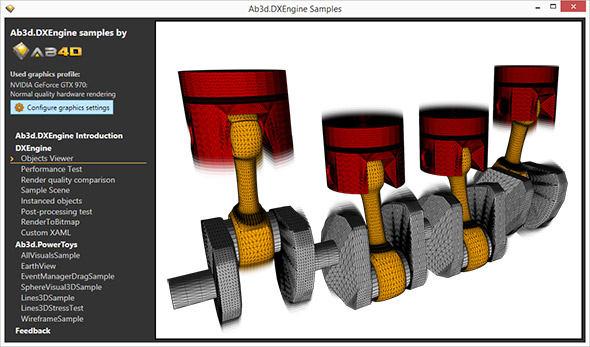DirectX 11 3D rendering engine for WPF and WinForms
Ab3d.DXEngine is a blazing fast 3D rendering engine that can be used in .Net Desktop applications.
Ab3d.DXEngine uses super fast multi-threading rendering techniques that can fully utilize graphics cards and provide the ultimate performance that is almost the same as when using C++.
The engine also supports top quality visuals with per-pixel lighting, PBR (physically based rendering) materials and shadows.
Ab3d.DXEngine is very easy to use. You can use WPF 3D objects to define the 3D scene, cameras and lights.
What is more, it works greatly with the Ab3d.PowerToys library - the ultimate 3D toolkit that gives you many building blocks to create a 3D application.

Main Ab3d.DXEngine features
- DirectX 11 based rendering engine with full hardware rendering support.
- Render millions of triangles with using instancing, smart optimizations and other techniques to get extreme GPU performance.
- Render millions of hardware accelerated 3D lines (super-smooth lines with custom thickness, line color and line pattern).
- Render millions of characters.
- Multi-threaded rendering that can in some cases achieve more then 4 times the performance of a single thread.
- With DirectX command list caching almost ANY number of objects can be rendered in practically no CPU time (can be used when only camera or lights are changed).
- Super-fast per pixel lighting and super-sampling for improved visual quality.
- Support standard and PBR (Physically Based Rendering) materials.
- Many post processing effects.
- The most versatile 3D engine - the same application can run on systems from high end graphics card (full hardware acceleration) to computers without graphics card (DirectX 11 software rendering). The same application can also run on an old computers with operating systems that do not support DirectX 11 (using WPF 3D rendering).
- The rendered 3D scene can be composed with existing WPF objects so that standard WPF controls can be added on top of the 3D scene or seen through the scene.
- Fully managed code that works with AnyCpu (x86, x64 or ARM) build targets and can be used in C# and VB.Net. DXEngine uses SharpDX as DirectX wrapper.
- Highly customizable: use custom shaders, rendering techniques, mesh data, etc.
- Import 3D models from STEP and IGES files. See CadImporter.
- Use new engine with just a few changes of the existing WPF 3D code. The engine fully supports Ab3d.PowerToys and Abd3.Reader3ds libraries.
- Great customer support by forum or email.
Ab3d.DXEngine is not another game engine (like Unity) that forces you to use its game editor, its architecture and requires many hacks and tricks to
be used in a standard .Net application.
The Ab3d.DXEngine is a new rendering engine that is built from ground up with the purpose to be used in standard Desktop .Net applications.
Samples screenshots
Versions history information
To see the development history of Ab3d.DXEngine, check out:
Download
 GitHub samples:
GitHub samples:
 NuGet packages:
Try for free now
NuGet packages:
Try for free now